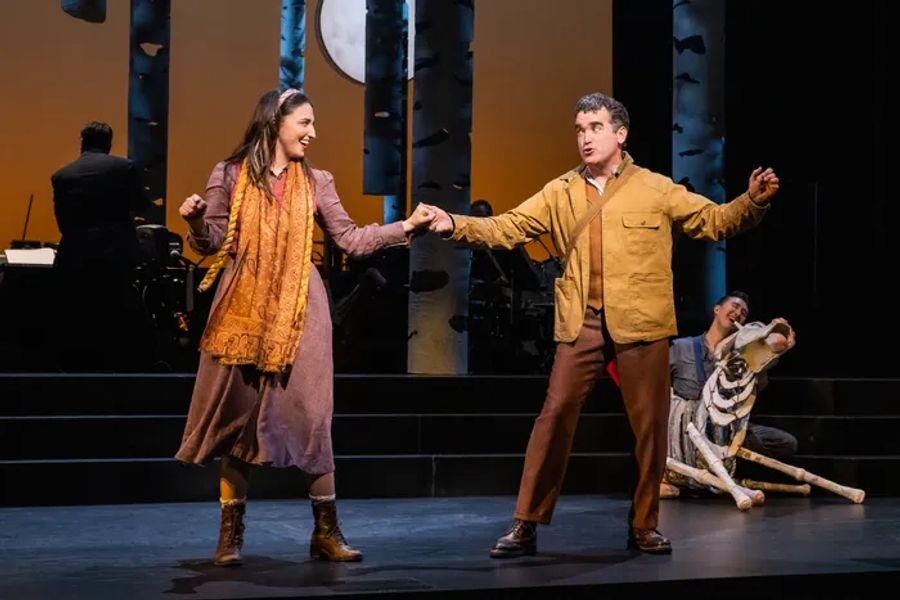The Baker’s Wife: More Than Just a Moment in ‘Into the Woods’
Sara Bareilles, Kerry O'Malley, and Joanna Gleason.
The 3 women who’ve played this pivotal Sondheim/Lapine role on Broadway talk about who she is, what she learns, and oh—by the way, does she have a name?
Originally published on AmericanTheatre.org
View this story online
Published July 18, 2022
The 3 women who’ve played this pivotal Sondheim/Lapine role on Broadway talk about who she is, what she learns, and oh—by the way, does she have a name?
In 2004’s “Fairytale,” songwriter Sara Bareilles’s feminist dismantling of happily ever after, she proudly declared, “I don’t want the next best thing.” The provocative pop song chronicled stories women’s lives after their royal weddings, finding Cinderella neglected by her Prince and Rapunzel longing for a haircut. Unimpressed by the princesses’ fates, Bareilles sang:
But the story needs some mending
And a better happy ending
‘Cause I don’t want the next best thing
Close to two decades later, Bareilles may have found it. The Tony-nominated composer is riffing on the Brothers Grimm again, this time with a starring role in the second Broadway revival of Into the Woods, which turns “Once upon a time” upside down, as wishes are made and spells are cast, but ever after isn’t necessarily happy.
Inspiring bedtime stories and Disney movies for more than 200 years, Jacob and Wilhelm Grimm’s stories are frequently interpreted and adapted, at times beyond recognition. Pensive, progressive, and darkly funny, Stephen Sondheim and James Lapine’s adaptation opened on Broadway to critical acclaim in 1987. A revival followed in 2002, and the current run, based on a concert staging as part of Encores!, opened July 10 at the St. James Theatre.
Along with the familiar Grimm tales (as well as Jack and the Beanstalk, which is of English origin), Sondheim and Lapine created two original characters, a baker and his wife. Cursed by a vengeful witch, the couple venture into the woods to break the spell that has left them childless.
Decades have passed between each production, but Into the Woods has remained timeless, with undeniable resonance to each moment it appears. The musical’s premiere during the AIDS epidemic inspired comparisons between its destructive giant to the deadly disease, while the sense of a community facing tragedy that followed the Sept. 11 attacks was felt in the 2002 revival.
Sara Bareilles and Brian D’Arcy James in “Into the Woods” on Broadway. (Photo by Evan Zimmerman for MurphyMade)
Today’s audience can choose from any number of current concerns that rhyme with the show’s themes, but perhaps the most striking and and visceral has to do with the show’s take on motherhood. In an exchange between the Baker’s Wife, played by Sara Bareilles, and Jack’s mother (Aymee Garcia), the Wife tells the mother she has no children, and Jack’s mom rapidly replies, “Oh, that’s okay too.”
“We get applause after that line, maybe not most nights, but a lot of the nights,” Bareilles said in a recent interview. “It just is a different time, especially in light of what’s going on with Roe v Wade, and women feeling disempowered in so many different ways.”
Directed by Lear deBessonet, the show both speaks to that feeling of disempowerment and, in subtle ways, defies it. Certain scenes are staged to only feature women onstage. A crucial line spoken by a male character in previous productions is now voiced by a female (i.e., the idea of smearing the ground with pitch to snare the lady giant, which comes from the Baker in the original, now comes from Cinderella).
The text offered many opportunities to emphasize feminine strength. Indeed, the role of the Baker’s Wife has long been considered one of Sondheim’s richest female characters, with complexities that have only deepend in each new production. Originated to Tony-winning fame by Joanna Gleason, the role was played by Kerry O’Malley in 2002, and is now brought to life by Bareilles.
As juicy as the part is, though, Bareilles spotted a downside.
“One of the things that struck me really early on, like day one of rehearsal, was she doesn’t have a name,” Bareilles said. Of course, neither does the Baker, but at least he’s not named in relation to his spouse. “She’s the Baker’s Wife,” Bareilles noted. “She is a possessive item by title! So I gave her a name. She’s Rebecca in my mind.”
Name aside, Bareilles felt immediate affection for her character. Living a simple life with her husband on the outskirts of a magical kingdom, she discovers new facets of her personality after leaving the familiar environment of her home. She’s more courageous, independent, and sexual than she knew.
“I love the spunk,” Bareilles said. “She’s feisty. She’s got opinions. I like to think she just has a big brain and she has a love for the world, and she’s maybe reconciling living a smaller life than she had anticipated.”
Chip Zien, Joanna Gleason, and Bernadette Peters in the original 1987 “Into the Woods.”
Gleason credited the character’s richness to librettist Lapine. “He wrote exactly what he needed, and not much changed,” she recalled. She did note that in contrast to some of the other characters, “There is something contemporary” about Baker and the Wife’s relationship, “this sort of bickering married couple.”
Indeed, from the start, their dynamic is familiar and hardly romantic.
“She is definitely the one who’s turning the wheels of their household and having to manage someone who’s mildly ineffectual in her husband,” Bareilles said of the part. “But there’s a lot of warmth there, and I think people relate to those relationships that are not perfect but functional, and there’s history and loyalty there.”
The woods are fertile ground for that loyalty to evolve as the couple rediscovers each other in their new environment. The Baker learns to appreciate his wife’s ingenuity and she praises his courage as they celebrate their newfound teamwork in the song, “It Takes Two.” And then there are three: As Act Two opens, the new parents are exhausted.
“When you get what you want, if you don’t have help, it’s really hard,” said Kerry O’Malley, who played the role in 2002. “You know that quote, ‘It takes a village.’ If you have rigid gender roles about who takes care of the child and who does the work, and if you’re doing everything and also taking care of the child and also would like to have romance in your life—it’s going to be really hard.”
A touch of romance comes as a surprise when the Baker’s Wife encounters Cinderella’s Prince in the woods. On the run from a giant and star-struck by royalty, she shares an unexpectedly passionate moment with the charming nobleman.
“I think of her as someone who buys the princess magazines at the bodega,” Bareilles said with a laugh. “When she gets to encounter the Prince, it’s like coming face to face with this reality that never materialized, but I think she may be somewhere had always dreamed for herself.”
Facing those dreams inspires an awakening within the Wife, who exclaims, “What am I doing here? This is ridiculous! I’m in the wrong story!”, a line famously first uttered by Gleason when Sondheim called her at home to discuss a new song for her character. “He wrote it out pretty much exactly like that,” Gleason recalled. “And he credits me, which is the great thrill of my life.”
That song became “Moments in the Woods,” a seeming stream-of-consciousness musing in which the Wife acknowledges her desires and reconciles them with her reality as she comes to a decision about her future.
“She just had something that would have been a dream for a peasant: an encounter with a prince,” Gleason said. “She’s had something that was romantic and new and different from the hardscrabble life of being a baker’s wife. It’s a kind of full flower of her femininity. She’s wondering, ‘If I go live in this fantasy or pretend this was anything more than a moment, at what cost?’ And the cost would be her Baker, her life, her love. So she has to make a decision through the song. It starts in confusion and it ends with a decision.”
Bareilles said she sees it as a moment of empowerment and clarity.
“I think she’s shocked herself with her actions, but I don’t feel like she’s feeling any shame or regret,” she said. “I don’t experience that song as remorse or ‘I wish that hadn’t happened.’ It’s like, ‘What a gift that that happened, because it’s awakened this new perspective that I can be grateful and present to what is in my life, knowing that it isn’t maybe exactly what I had wished for.’”
Kerry O’Malley and Stephen DeRosa in the 2002 revival of “Into the Woods.”
The privacy of the moment—the only time in the show that the Wife is alone onstage with her thoughts—further emphasizes the uniqueness of her story. And indeed it remains private: Her husband never learns of her brief dalliance.
“I think we all have these moments where our life gets changed by a choice or a crossroads,” O’Malley said. “We all have personal experiences that change our lives that are not shared by other people. That moment in the woods changes her life, her perception of who she is, her marriage, how she wants to be a mother, and she’s the only one who experiences it.”
Of course, this change is short-lived, as she’s squashed by the giant immediately following her song. O’Malley said she’s heard some interpret these two events as causally linked—folks who “think that the Baker’s Wife is being punished for adultery, that she dies because she cheated, that there’s some kind of message there. James Lapine said absolutely not. That was not the intent. She died because she died; she’s the one in the vicinity when the giant is stomping on people.”
Indeed, in the show’s morally complex world, there are no clear-cut heroes or villains, and no explanations for the tragedies. Bareilles said she feels that resonate deeply with audiences. Coming together to battle the giant, the characters embody a sense of community at a time that feels cynical and divisive outside the theatre’s doors.
“The collective resilience of this community of people—they’re messed up, they’re broken, they make mistakes, they fail,” Bareilles said. “They leave you in the woods. It’s the human condition that is just so baked into that piece on such a deep level, and it’s a tremendous gift to be a part of that storytelling, and also to get to witness how this has landed on our audience right now.”
Said Gleason, “Into the Woods is a haven, because you can interpret and you can absorb as much of real life as you want to watch that show. Different ages will feel different things. Parents will feel different things than their children will feel. It’s part of the magic that it really can say as much or as little as you feel you want it to say.”
Carey Purcell (she/her) writes about pop culture and politics for Vanity Fair, Politico, and other publications, and blogs at CareyPurcell.com. She recently published her first book, From Aphra Behn to Fun Home: A Cultural History of Feminist Theater.




